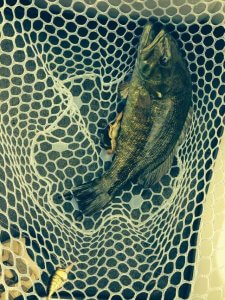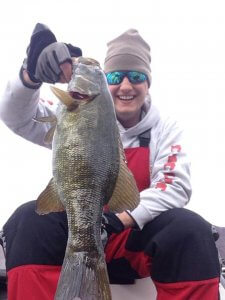A Guide to Asheville Smallmouth Fly Fishing
It is the time of year when water levels are high, and big fish are feeding! Asheville, North Carolina can offer the angler with a trophy smallmouth fishing during the spring and early summer months.
The Smallie Run
Do smallmouth really ‘run’ like stripers? Not really, but if you get in the right spot you can see packs of bronze backs heading in the same direction to spawn. During the months of April and May, Asheville’s native smallmouth will venture up small tributary creeks in search of a place to spawn. Most of these spawning activities in the river will happen within a one week to two interval. After the spawn is over the fish will move to the deepest pockets you can find in search of food.
The Forage is What?

Asheville smallmouth fishing
Smallmouth can be caught a number of different ways year round, but when the search is on for a big smallmouth in WNC’s river systems, big baits usually dominate. When most anglers thing of fly fishing for smallmouth, the typically popper and mouse pattern come to mind. These patterns can work very well in the warmer summer months, and even the later fall months, but lets take a step back and think about what smallmouth are really eating.
As the water begins to warm up critters begin to move out of their holes and start to taunt the fish. These critters include crawfish, leeches, big stoneflies, small rodents and other river critters. Smallmouth also enjoy Western North Carolina’s War Pain Minnow – a native minnow that is found all throughout Western North Carolina. Smallmouth will also feed on trout throughout the year.
You’re Throwing What?
Don’t just stick to the regular old popper method when fishing for smallmouth! Although a proven technique and a blast to throw, the popper can hinder your approach when targeting giant river smallmouth. When going after the 3lb. plus range, try throwing big streamers, minnow pattern flies with flash, and crawfish imitations. These flies can do some damage when casting to deeper pools. Use sinking tip fly line to get rabbit fur streamers to the depths where you think smallmouth may be hiding.
For finesse, light spin tackle try hair jigs to imitate crawfish and jerbaits to get down deeper. Jerkbaits are proven effective in the spring and summer months as the big smallmouth are not used to seeing them, and are more willing to strike.
What Type of Line? Fly & Spin!
 The type of fly line depends on what you are throwing. If you decide to cast poppers all day in hopes of a topwater bite then 6-8wt WF floating fly line is best. This will help your popper stay up and provide a good action for smallies looking for a topwater meal. If you are throwing streamers in deeper pockets and deeper water a sinking tip fly line will work best to get your fly down as deep as possible. Smallmouth will usually be hiding under rocks or ledges in search for crawfish, leeches and minnows.
The type of fly line depends on what you are throwing. If you decide to cast poppers all day in hopes of a topwater bite then 6-8wt WF floating fly line is best. This will help your popper stay up and provide a good action for smallies looking for a topwater meal. If you are throwing streamers in deeper pockets and deeper water a sinking tip fly line will work best to get your fly down as deep as possible. Smallmouth will usually be hiding under rocks or ledges in search for crawfish, leeches and minnows.
For spinning tackle, this will depend if you are using a fast action bait (subsurface) or a jig of some sort. We recommend that all faster, subsurface baits are thrown on monofilament line in the 6 to 8 pound test range. The monofilament will help your bait stay in the higher water column when using subsurface baits or shallow jerkbaits. Monofilament is also easy to stretch, unlike it’s stiff cousin – fluorocarbon; this will help you not break off every time you throw your bait over a rock ledge or behind a current break. If you are throwing a jig and want to get down deeper, we recommend using a braided line with a fluorocarbon leader. This will provide strength and durability to your line when getting down deeper and rolling your jig off large boulders and inbetween rock ledges. The fluorocarbon leader will also help you feel bites easier when your jig is in a deep pocket.
Contact Us
Contact Southern Appalachian Anglers for more information regarding smallmouth fishing and how and where to go for your smallmouth fishing trip. If you are looking to book a trophy guided smallmouth fishing trip contact us online or give us a call at 828-691-1506.
